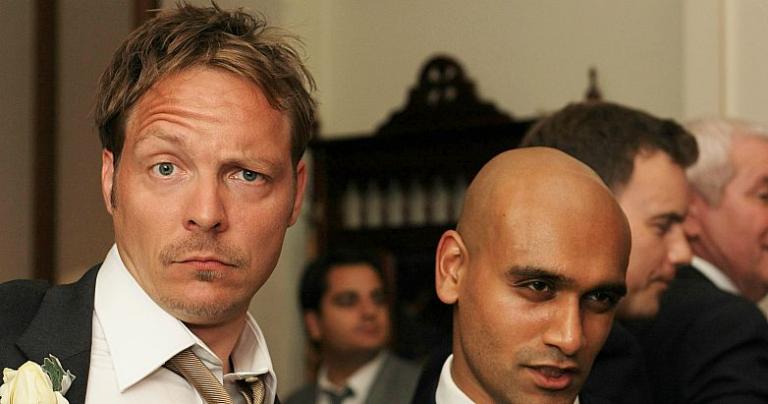
Does the Bible say that life begins at first breath? If so, that strengthens the pro-choice argument.
Tim Barnett from the Stand to Reason ministry uses his background as a teacher to grade the logic of arguments that attack his conservative Christian beliefs. His video series is called Red Pen Logic. Today’s topic is, “The Bible Doesn’t Say What He Thinks It Says.”
The problem comes from actor and political commentator John Fugelsang, who attacked the popular Christian claim that life begins at conception with this tweet:
Well don’t tell God [that life begins at conception], bc the Bible says Life begins at First Breath.
Sorry, I didn’t write it.
Fugelsang is probably referring to this verse from the Garden of Eden story: “Then the Lord God formed a man from the dust of the ground and breathed into his nostrils the breath of life, and the man became a living being” (Genesis 2:7).
The importance of “breath”
Barnett responded that God breathed into Adam, and then Adam came to life. The “breath” wasn’t Adam’s first breath, like a newborn’s first breath would be. This is a unique situation and doesn’t apply elsewhere.
But the Jewish interpretation disagrees, and this is critical since Jesus was a Jew. Breath is central to the Genesis idea of life. In the verse above, “the man became a living being,” is literally translated as, “the man became a breathing creature.” Breath is roughly synonymous with life.
Not only does the Bible say that the “breath of life” is what living things have, it’s what they don’t have when they die. This is what the dying animals during the Flood lost: “Everything on dry land that had the breath of life in its nostrils died” (Gen. 7:22). Another example is from the Canaanite genocide: “But as for the towns of these peoples that the Lord your God is giving you as an inheritance, you must not let anything that breathes remain alive” (Deuteronomy 20:16). One commentary says, “Breath is understood to be essential to life; and that when the breathing stops, life ends.”
The Christian case
And now comes the obligatory dueling Bible quotes part of the argument. Barnett says that the Bible recognizes life before “first breath” and says, “The Bible consistently elevates the status of unborn humans to valuable individuals.”
He cites two Bible passages. First, “You formed my inward parts; you knitted me together in my mother’s womb” (Psalm 139:13). That sounds pretty bland, but Barnett interprets this to mean that we exist “as ourselves” before birth.
I don’t see it. First, “knitted” (Strong’s #05526) is more literally “wove,” as would be done with a protective screen or fence woven from branches, and by implication it can mean to fence in, cover, or protect. Yes, it’s important for a fetus to be in a protective womb when it is developing, but this simply acknowledges the gestation process. During that process, you aren’t you, but (with luck) you will be by the end.
Read that entire psalm. It’s a worshipful acknowledgement of God’s omniscience and power. Some variation on “you were you even at the beginning of the gestation process” is not the message.
Barnett’s second Bible response is Luke 1:41–44 where John the Baptist (as a fetus in his mother Elizabeth) leapt for joy when he first came in contact with Jesus (as a younger fetus in Mary). He tells us, “Jesus and John were themselves long before first breath.”
What does that even mean? Yes, the process of gestation was underway. That’s it. At that stage, they might have looked to the untrained eye indistinguishable from an elephant. “[They] were themselves” distills down to their DNA being in place and functioning, I guess—pretty underwhelming.
Passages on the other side of the question
Let’s return to the Bible for verses showing God’s attitude toward life. Exodus 21:22–3 says that if a man injures a woman and causes a miscarriage, he is only fined. If instead he causes an injury to the woman, he is penalized “an eye for an eye.” In other words, a fetus is less important than an adult.
Here, though, experts differ on the best interpretation. Are we talking about a miscarriage (the fetus dies) or just a premature birth (it lives)? If the latter, just a fine might be reasonable. This passage doesn’t help us much.
Another is the “trial of the bitter water” in Numbers 5. Here, the issue is a husband who suspects his wife of adultery. The priest creates a potion for the wife to drink, with a curse if she’s guilty. To be clear, the problem isn’t “My wife is pregnant, and I want that fetus gone if it’s not mine” but rather “I need to know if my wife has been unfaithful.” (More here.)
God’s judgment on the woman, if guilty, sounds like a prolapsed uterus. And if the woman were pregnant, that curse would likely cause a miscarriage. God clearly doesn’t much care about a little collateral damage in the pursuit of justice. Maybe pro-lifers like Barrett should take the hint.
The hint gets far louder when you remember God’s rampages. He drowned almost all the life on the planet, and he commanded genocide.
He even demanded human sacrifice. First, he created the law:
Consecrate to me every firstborn male. The first offspring of every womb among the Israelites belongs to me, whether human or animal (Exodus 13:2).
And later, he mocked Israel for it:
So I gave them other statutes that were not good and laws through which they could not live; I defiled them through their gifts—the sacrifice of every firstborn—that I might fill them with horror so they would know that I am Jehovah (Ezekiel 20:25–6).
And the Bible contains a scattering of killings to show that God doesn’t place the lives of babies at the top of his list (see here and here).
Jewish sources on abortion
The Talmud is the source of religious law for rabbinic Judaism. It draws the rather common sense conclusion that the fetus, especially in its earliest days, has a very different moral value than a human child or adult: “The [Talmud] states that: ‘the embryo is considered to be mere water until the fortieth day.’ Afterwards, it is considered subhuman until it is born” (source).
Another source says,
Unlike in Catholicism, in Judaism the fetus isn’t a legal person until it’s born, so abortion can’t be murder. (This isn’t even as different from Catholicism as it seems. The Catholic Church itself didn’t insist that life began at conception until 1869. Before that, the Church tolerated abortions through the 40th day of pregnancy.)
About the abortion debate, one rabbi said,
Most of the [Old Testament verses] that [conservative Christians are] bringing in for this are ridiculous. They’re using my sacred text to justify taking away my rights in a way that is just so calculated and craven.
When does life begin?
This is Barnett’s final question, and here he turns to science rather than the Bible. He cited a book on embryology that said, “[an embryo] is a human being from the time of fertilization.”
This doesn’t help. It just raises the question, what is a “human being”? If it’s by definition a Homo sapiens life form from single fertilized egg cell until death, then sure. But quoting a definition is no argument.
Let me respond with three points. First, the answer to “When did life begin?” is “Life began on earth about 3.5 billion years ago.” The egg and sperm are already alive, so when they join, the fertilized egg cell doesn’t then become alive. What begins is the gestation process for a new offspring.
Note how off-target the mindless celebration of “life” can be. Slugs and mosquitoes are alive, but pests don’t have much inherent value. There’s a range of value here, and we kill living things all the time. We’re all on the same page about the value of a newborn. The problem is giving that single cell the value of a newborn right now, not nine months from now.
A newborn is really complicated
And finally, that brings us to the strangely appealing desire that sucks in many conservative Christians, the need to dismiss the changes that happen during the course of a human pregnancy. Comparing the two ends of that process, there are a few things that are the same. The single cell and the newborn are both alive, and they both have H. sapiens DNA. That’s about it.
But there are some things that are radically different. The newborn has about one trillion (1,000,000,000,000) cells, each one differentiated and fitted with other cells in a precise arrangement. The single cell is . . . 1 cell. The newborn has arms and legs, eyes and ears, a stomach and digestive system, brain and nervous system, heart and circulatory system, skin, liver, and on and on. The single cell doesn’t have a single cell of any of this.
If you want to define “human being” so that it includes both newborn and single cell, that’s fine. But then you need to come up with some term that describes that gap. We have lots of words for subtle differences among young children—newborn, baby, child, infant, toddler, and so on—so surely we can find a word for the enormous change that happens from fertilization until birth. For example, I’d say that a newborn is a person while the single cell isn’t. If you object to the word “person,” then suggest something better. We need a term like “personhood” to describe the enormous spectrum from single cell (not at all a person) to the newborn (100% person).
Biblical arguments have no place in making laws in a country governed by a secular constitution like the United States. And even when we look in the Bible to see what it says, the pro-life argument is poorly supported.
to vote against everything Christ talked about,
by talking about something Christ never talked about.
— @JohnFugelsang
.
Image from Kelly Sikkema (free-use license)
.


















